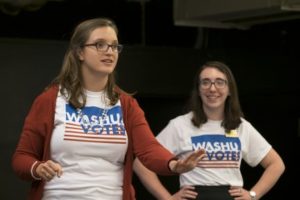Thousands of Washington University in St. Louis students are expected to vote Tuesday, Nov. 8, many for the first time. To make the experience easy, and memorable, the university has established one central polling location for students who live on campus, and it will host an evening watch party at the Danforth University Center.

“Getting that first ‘I voted’ sticker is so exciting,” said Cassie Klosterman, voter engagement fellow at the Gephardt Institute for Civic and Community Engagement and a 2016 graduate of Arts & Sciences. “There will be a festive mood all day on campus.”
An anticipated 1,500 to 2,000 South 40 and Village residents will vote at the Athletic Complex. The Gephardt Institute will serve hot cocoa and cider to waiting voters and the Office of Public Affairs will host a voting pop-up tent from 11 a.m. to 2 p.m. with carnival games, swag, a selfie booth and cake pops. Social Programming Board and Washington University Political Review will throw an election party with free food at 7 p.m. in the Danforth University Center.
Klosterman recommends students plan in advance when they will vote and to bring a friend to the polls.
“Don’t let the day slip away,” Klosterman said. “Keep in mind, there may be lines so having a voting buddy can be a good motivator.”
The Gephardt Institute registered 3,608 new voters — some 25 percent of the student body — this academic year through the online platform TurboVote. Approximately 70 percent of those students register to vote in Missouri.
TurboVote ranks Washington University No. 3 in overall number of registrations and No. 2 in percent of the student body registered. Thousands of other students registered on their own.
Klosterman won’t know the total number of students who registered or voted until spring, when Tufts University completes its National Study of Learning, Voting, and Engagement. The Gephardt Institute set a goal of an 80 percent registration rate and a 65 percent voting rate. In 2012, some 72 percent of Washington University’s 13,600 students registered, and some 56 percent of those students voted.
“My hope is that we reach or exceed that goal,” Klosterman said. “But what’s even more important is that our students are staying engaged in the political process.”